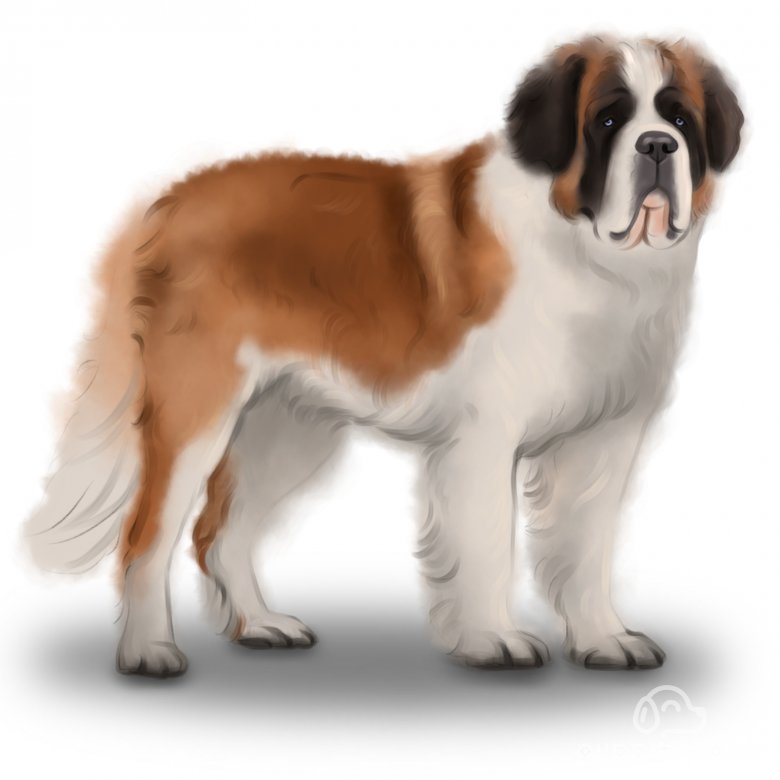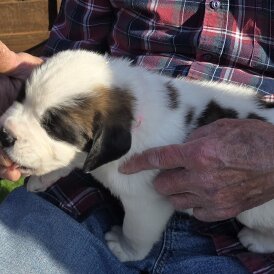Why St Bernards are great
St Bernards are much loved around the world for many reasons; they are good-natured, gentle and their patience makes them great family dogs. This breed is surprisingly adaptable and versatile and can happily live in smaller homes as long as they are exercised each day. Some highlights:
Good-natured and gentle
Intelligent and quick to learn
Low maintenance in terms of grooming
Impressive watchdogs thanks to their huge size
Things to consider when looking at St Bernards for Sale
St Bernards are wonderful family pets but there are a few things to keep in mind. These big dogs can be quite messy as they drool and shed so if you like your house to be pristine they are maybe not the best choice. Other considerations are that they are extremely strong and they can overheat easily. Some downsides to the St Bernard:
Very large in size so need enough room
They shed A LOT all year
Can be overprotective
History of St Bernards
The St Bernard is a breed that originated in Switzerland, although there are no detailed records of the dates of this breed's origin. It is believed that the dogs were first kept at the Hospice of the Saint Bernard Pass from the 1600s. They were initially used by the Hospice to guard the grounds and protect the monks when they searched for lost travellers along the well-known but treacherous route of the Saint Bernard Pass. It was then realised that these dogs were excellent in their ability to locate paths and find travellers. Upon discovering their life-saving abilities, St Bernards were utilised for assisting in the rescue of travellers. This work continued and packs of 2 or 3 dogs would go out to look for lost or injured people. If the dogs found a person, one would return to the hospice to alert the monks to the trapped traveller while the others would keep the person warm. The Hospice records credit St Bernards to saving over 2,000 travellers. Between 1800 and 1810 a St Bernard named Barry had located and rescued 40 travellers, his incredible efforts brought him fame and caused many people to refer to St Bernards as “Barry” dogs. This breed was not actually officially recognised as ‘St Bernard’ until 1880 when the Swiss Kennel Club documented the breed under the name. In 1885 the American Kennel Club recognised the breed and in 1887 the Saint Bernard Club of America was formed. St Bernards are regarded as Switzerland’s national dog. They have been featured in many films and remain popular to this day.
Appearance
The St Bernard is a well-known, large, strong dog that has a huge head and a short, wide muzzle. Their broad nose, dark eyes and large, floppy ears are characteristic of this breed. The St Bernard truly is a charming, affectionate, gentle giant so don’t let their large size intimidate you.
How big is the St Bernard?
St Bernards are huge dogs. Females are slightly smaller at 65 – 70cm at the withers and males are 70 – 80cm at the withers.
How heavy is a St Bernard?
You can expect your St Bernard to weigh between 55 – 80kg when fully-grown.
What Colour is the St Bernard?
St Bernards can be shorthaired or longhaired and are one of the most recognised dogs in the world. They come in white with varying shades of brown/ red/ mahogany/ orange. The colour can be anything from brindle to brownish-yellow. They are white around the neck, nose, chest, feet and the tip of the tail. It is generally desirable to have a white blaze on the face (the dark markings almost resemble a mask with this white blaze).
Temperament
The affectionate nature of St Bernards is well documented, they are famous for being mountain rescue dogs and their gentle nature has touched hearts across the globe. The laid-back character of a St Bernard is complimented by their loyalty, intelligence and social personality.
Do St Bernards make good guard dogs?
These large, loyal dogs are not natural guard dogs, they are rarely aggressive and much prefer to be inside with their family. With that said, they will bark when there is a cause for it.
Do St Bernards bark a lot?
Generally, St Bernards are quiet dogs and they will only bark when there is good reason to.
Are St Bernards easy to train?
St Bernards are eager to please so are relatively easy to train despite their large size. Early training and socialisation is essential.
Are St Bernards playful?
They have a playful side to their personalities and enjoy entertaining their owners. Although they do enjoy their quiet time and will only play when they feel like it as they can overheat quickly.
Are St Bernards good with children?
Yes, St Bernards are very gentle and loving dogs making them a great choice as a family pet. These dogs thrive in a family environment.
Are St Bernards good with other pets?
Yes, generally St Bernards get on well with other pets. They have a social nature but introductions with animals they do not know or have not grown up with should always be carried out with care.
Can I leave a St Bernard Alone?
These dogs form strong bonds with their family and are not happy when left alone for long period of time. They are best suited to a living situation where there is always one person at home.
Do St Bernards like water?
Yes, most St Bernards like water and often love to swim when the weather is hot.
Health
Unfortunately, these large dogs have a shorter than average lifespan and can suffer from a number of health problems.
How long do St Bernards live?
8 – 10 years
How much exercise does a St Bernard need?
Your St Bernard will need at least one long walk each day. Remember not to exercise them during the heat of the day as their dense, thick coats cause them to overheat quickly.
What are St Bernards Common health issues?
St Bernards are prone to:
Hip and elbow dysplasia
Heart problems such as Dilated Cardiomyopathy (DCM)
Skin problems particularly around their lip folds and their ears
Cancers including osteosarcoma, lymphoma and neoplasia
Care
How much space do I need for a St Bernard?
Although very large in size, St Bernards can live in small homes as long as they have an enclosed outside area to enjoy. Apartments are not ideal for these dogs but as they are relatively inactive when inside they don’t need as much space as you may first think.
What should I feed my St Bernard?
A good quality diet is essential to keep your dog in good health. When you first bring your St Bernard puppy home it is important to follow the feeding schedule provided by the breeder. Any changes to your dog’s diet should be made gradually to avoid stomach upsets. St Bernards are prone to bloat so it is best to feed them two smaller portions rather than one big meal each day. As a rough guide, if your St Bernard weighs 75kg then they should be eating 630-830g each day depending on activity levels.
How much grooming do St Bernards need?
St Bernards coats require very little maintenance and brushing them a couple of time a week should be enough to keep their coats lush and free from tangles.
Do St Bernards shed?
Yes, St Bernards shed a lot. They will shed all year round with increased shedding twice a year in Spring and Autumn. Despite the shedding, grooming a St Bernard is relatively low maintenance.
Average costs
How much does it cost to keep a St Bernard?
As a rough guide in pricing: Cost to buy: roughly £850+ for a well-bred St Bernard puppy Other costs (Vet, Food etc): £120 per month
Specific Buying Guide
You can read our general buying guide here (/advice-on-buying-a-puppy/), with the most important thing being going to view your St Bernard Puppy, seeing it with its mother, and checking the quality of the breeder. More specifically, here is some St Bernard puppy buying advice:
Be aware of breeders that are using the breed to try to make a quick profit. As St Bernards are among the most popular dogs in the UK there will be some breeders that are not reputable trying to sell puppies without providing the proper care or adhering to welfare guidelines.
Never buy a puppy online without seeing the puppy and the breeders home or business to confirm they are genuine and not a scam.
Avoid puppies with exaggerated features as this is a sign of bad breeding practices.
Other reading, Adopting St Bernard Puppies and Rescue Organisations
A big thank you to the following sources who helped to shape this article: https://www.akc.org/dog-breeds/st-bernard/ https://saintbernardclub.org/ https://www.stbernard.org.au/ https://stbernardtrust.com/

















